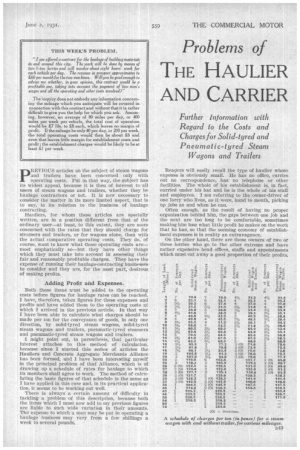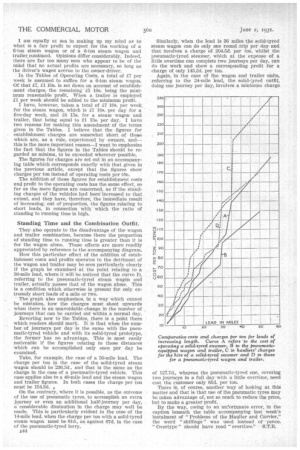Problems of
Page 61

Page 62

If you've noticed an error in this article please click here to report it so we can fix it.
THE HAULIER
AND CARRIER
Further Information with Regard to the costs and Charges for Solid-tyred and Pneumatie-tyred Steam
Wagons and Trailers
pREVIOUS articles on the subject of steam wagons and trailers have been concerned only with operating costs. Put in that way, the subject has its widest appeal, because it is then of interest to-all users of steam wagons and trailers, whether they be haulage contractors or net. It is now necessary to consider the matter in its more limited aspect, that is. to say, in its relation to the business of haulage contracting.
Hauliers, for whom these articles are specially written, are in a position different from that of the ordinary user-at least, to this extent, they are more concerned with the rates that they should charge for steamers and trailers, or for wagons alone, than with the actual comparative operating costs. They do,' of course, want to know what those operating costs aremost emphatically so-but they have other things which they must take into account in assessing their fair and reasonably profitable charges. They have the expense of running their haulage-contracting businesses to consider and they are, for the most part, desirous of making profits.
Adding Profit and Expenses.
Both these item § must be added to the operating costs before figures for haulage rates can be reached.
I have, therefore, taken figures for these expenses and profits and have added them to the operating costs at which I arrived in the previous article. In that way I have been able to calculate what charges should be made per ton for the conveyance of goods, in only one direction, by solid-tyred steam wagons, solid-tyred steam wagons and trailers, pneumatic-tyred steamers and pneumatic-tyred steam wagons and trailers.
I might point out, in parenthesis, that particular interest attaches to this method of calculation, because since I started this series of articles the Hauliers and Concrete Aggregate Merchants Alliance has been formed, and I have been interesting myself in the principal problem of that. Alliance, which is of drawing up a schedule of rates for haulage to which its members shall agree to work. The method of calculating the basic figures of that schedule is the same as
I have applied in this case and, in its practical application, it seem S to be working out well.
There is always a certain amount of difficulty in tackling a problem of this description, because both the items which I must now add to my previous figures are liable to such wide variation in their amounts. The eipense to which ti. man may be put in operating a haulage business may N=ary from a few shillings a week to several pounds.
Readers will easily recall the type of haulier whose expense is obviously small. He has no office, carries
• out no correspondence, has no telephone or other facilities. The whole of his establishment is, in fact, -carried under his hat and lie is the whole of his staff and employees. I am referring to the owner-driver of one lorry who lives, as it were, hand to mouth, picking up jobs as and when he can.
Often enough, as the result of having no proper organization behind him, the gaps between one job and the next are too long to be comfortable-, sometimes making him lose what little profit he makes on the work that he has, so that the seeming economy of establishment expenses is in reality an extravagance.
On the oilier hand, there are those owners of two or • three lorries who go to the other extreme -and have rather expensive head ()likes, staffs and appointments which must eat away a good proportion of their profits. I am equally at sea in making up my mind as to what is a fair profit to expect for the working of a 6-ton steam wagon or of a 6-ton steam wagon and trailei; combined. Opinions differ considerably. Indeed, there are far too many men who appear to be of the mind that no actual profits are necessary, so long as the driver's wages accrue to the owner-driver.
In the Tables of Operating Costs, a total of £7 per week is assumed to suffice for a 6-ton steam wagon. Of that £7, 11 Is. is set down on account of establishment charges, the remaining" £5 10s. being the minimum reasonable profit. When a trailer is employed per week should be added to the minimum profit.
I have, however, taken a total of 17 10s. per week. for the steam wagon, which is £1 10s. per day for a five-day week, and £8 15s, for a steam wagon and trailer, that being equal to £1 15s. per day. I have two reasons for making this amendment of the terms given in the Tables.--believe believe that the figures for establishment charges are somewhat short of those which are, as a rule, experienced by owners, and— this is the more important reason—I want to emphasize the fact that the figures in the Tables should be regarded as minima, to be exceeded wherever possible.
The figures for charges are set out in an accompanying table which corresponds exactly with that given in the previous article, except that the figures show charges per tan instead of operating hosts per ton.
The addition of those figures for establishment costs and profit to the operating costs has the same effect, so far as the mere figures are concerned, as if the standing charges of the vehicles had been increased to that extent, and they have, therefore, the immediate result of increasing; out of proportion, the figures relating to short leads, in connection with which the ratioof standing to running time is high.
Standing Time and the Combination Outfit.
They also operate to the disadvantage of the wagon and trailer combination, because there the proportion of standing time to running time is greater than it is for the wagon alone. These effects are more readily appreciated by reference to the accompanying diagram.
Ilow this particular effect of the addition of establishment costs and profits operates to the detriment of the wagon and trailer may be seen particularly clearly if the graph be examined at the point relating to a 30-mile lead, where it will be noticed that the curve D, referring to the pneumatic-tyred steam wagon and trailer, actually passes that of the wagon alone. This is a condition which otherwise is present for only extremely short leads of a.mile or two.
The graph also emphasizes, in a way which cannot be mistaken, how the charges must shoot upwards when there is an unavoidable change In the number of journeys that can be carried out within a normal day.
Reverting now to the Tables, there is a point there which readers should mark. It is that when the number, of journeys per day is the same with the pneumatic-tyred vehicle and with its solid-tyred prototype, the former has no advantage. This is most easily noticeable if the figures relating to those distances which can be accomplished only once per day be examined.
Take, for example, the case of a 50-mile lead. The .charge per ton in the case of the solid-tyred steam wagon should be-236.5d., and that is the same as the charge in the case of a pneumatic-tyred vehicle. This case applies also to a 40-mile lead and the steam wagon and trailer figures. In both cases the charge per ton must be I54.3d.
On the contrary, where it is possible, as the outcome of the use of pneumatic tyres, to accomplish an extra journey or even an additional half-journey per day, a considerable diminution in the charge may well be made. This is particularly evident in the case of the 14-mile lead, when the charge per ton with a solid-tyred steam wagon must be Sid., as against 67d. in the case of the pneumatic-tyred lorry.
n44 Similarly, when the lead is 36 miles the solid-tyred steam wagon can do only one round trip per day and that involves a charge of 204.5d. per ton, whilst the pneumatic-tyred steamer, which at the expense • of a little overtime can complete two journeys per day, can do the work and show a corresponding profit for a charge of only 1452d. per ton.
Again, in the case of the wagon and trailer units, referring to the 24-mile lead, the solid-tyred outfit, doing one journey per day, involves a minimum charge of 127.7d., whereas the pneumatic-tyred one, covering two journeys in a full day with a little overtime, need cost the customer only 85th per ton.
There is, of course, another way of looking at this matter and that is that use of the pneumatic tyres may be taken advantage of, not so much to reduce the price, but to make a greater profit.
By the way, owing to an unfortunate error, in the caption beneath the table accompanying last week's instalment of "Problems of the Haulier and Carrier," the word " shillings " was used instead of pence. " Overtype " should have read " overtime." S.T.R.




































































































